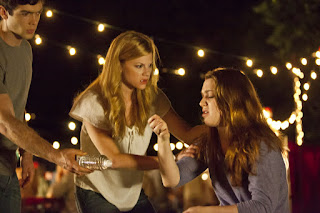Yes, I'm still that person who gets physical DVDs from Netflix. My queue is over 200 movies and counting, made up mostly of random cult films or the kind that are not nearly cool enough to make it past any millennial programming the streaming choices on digital platforms.
The problem with a queue amassed over 10 years is that sometimes, a disk will show up in the mail that I have no memory of adding. Such is the case with today's straight-to-DVD horror flick, a film notable only, as far as I can see, for being produced and having its music done by Slash.
Then again, it does star one of my ultimate film crushes...
Quick Plot: Pastor Dan is moving his wife and three kids to Stull, a rural Kansas town where he has been appointed to take over minister duties being vacated by Pastor Kingsman, played by the always perfect Clancy Brown. The townspeople are excited to welcome a new family, helping them unload their moving truck and baking a gloriously decorative cake for their enjoyment.
Eldest teen daughter Becca begins a quick flirtation with local farmboy orphan Noah, while middle child Mary decides to have herself a slice while her folks are unpacking, only to discover she's bitten right into a mysteriously marked giant tooth. Noah dismisses it as a product of the nonagenarian baker, but clearly, there's more to the icing.
As Noah and Becca continue their romance, the family heads to the town's summer festival, where Mary becomes mysteriously ill from some spiked lemonade and awakens to discover herself tied up to be a sacrifice to the devil.
Being the new kid in town is a tough gig.
Turns out, Stull, KA, has a long tradition of turning their new citizens into portals for Satan. Mary becomes a vessel for a veiny CGI demon who slaughters anyone not protected by some biblical Stull rituals.
Like I said: I know nothing about Nothing Left to Fear regarding why I ever found it interesting enough to order in DVD format. It's the sole directing credit of Anthony Leonardi III, who primarily works as a storyboard artist on a grander scale with Game of Thrones and some big budget films. The Kansas setting is a little more interesting to look at than most of this genre's backgrounds, but there's not quite enough done with change in scenery to really make much of it as a backdrop.
No, I likely added this movie because of my love for Clancy Brown.
Here's the thing about Brown: like my other character actor crush of the same generation who never gets enough respect, he might choose less-than-stellar projects, but he is never, and I really do mean never, not amazing in them. Like Michael Ironside, Clancy Brown gives his work his all, even if the material doesn't necessarily warrant it.
Overall, Nothing Left to Fear is fine. Its loose Shirley Jackson's The Lottery vibes could have been used to much more interesting effect, but it does tell a fairly fresh story in a genre that so often feels stale. You could certainly do worse, but considering some of this film's strong elements--an attractively sprawling setting, twists on traditional religious horror concepts, Slash scoring, and, you know, Clancy Brown--it just also feels like this movie should have been more memorable.
High Points
I love a well-done circular ending, and Nothing Left to Fear makes good use of that here
Low Points
Hey, I know a limited budget when I see one (even if it could afford Anne Heche is a fairly wasted role), but in 2013, cheap CGI didn't have to look this much like cheap CGI
Lessons Learned
Nothing turns a preacher's daughter on faster than sheep's blood
First dates are always better when done montage style
There are reasons people don't up and move their family to small towns in Kansas, and perhaps you should consider them before up and moving your family to a small town in Kansas
Rent/Bury/Buy
Well, I had to rent Nothing Left to Fear on DVD for SOME reason I'll never remember in my past, but unless you're a mark for rural or religion-based horror relying on CGI, it's probably not worth hunting down. Should it pop into a streaming site I'd recommend giving it your eyeballs with measured expectations.
























































